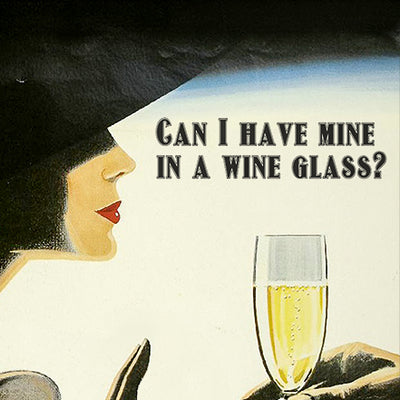
Champagne glassware: the flute’s swansong?
Champagne, as a beacon of celebration, has long been adorned in varying glassware styles according to fashion and functionality, each promising to elevate its effervescent qualities in a unique manner. But as we navigate the aesthetics and advantages of each, one might wonder: is the era of the classic champagne flute drawing to a close?
The coupe
Before we discuss the flute, its cultural predecessor must be addressed. Exuding vintage glamour, the coupe has often been associated with the sparkling soirées of the early 20th century. Its broad, shallow bowl makes it visually appealing and superbly suited for festive toasts, elegantly perched on the fingertips of the sophisticated elite.
Despite spurious claims of it being modeled on Marie Antoinette’s breast, some believe that its design was more functionally intentional. The wide-open shape allowed the harsh effervescence and acidity of earlier styles of Champagne to dissipate quickly, allowing for a more approachable drinking experience. However, this would also cause the aromas to fade and the wine to oxidize more rapidly. Overall, while the Coupe looks suave, it lacks the precision to appreciate good Champagne.
The flute
With its elongated, slender form, the flute is universally symbolic of sparkling wine consumption. Often using a single nucleation point etched into the glass, flutes create a steady stream of elegant bubbles. Its design is not merely aesthetic, however; the narrow shape helps preserve carbonation and directs the bouquet toward the nose when sipping.
However, as preferences evolve towards a deeper appreciation of Champagne’s complex flavors, the flute’s limitations come into sharper focus. With its tapered form, swirling the wine to release its bouquet often results in spillage, aromatics are not easily chambered at the top, and its restricted opening limits aromatic expression and impedes nosing. It hardly seems a fitting vessel for some of the finest wines in the world.
“While the classic, narrow flute is commonly used and offers a beautiful display of effervescence, it can inhibit our ability to explore the depth of aroma and flavor in that wine.”
– Hugh Davies, Winemaker/CEO, Schramsberg Vineyards
The tulip
The tulip glass, with its wider bowl and slightly closed rim, is seen by many connoisseurs as a superior alternative to the flute. It offers a clear middle ground; elegance, but with enough openness to amplify the aromas and flavors, and a tapered top to capture the bouquet, allowing a nuanced appreciation of the wine’s complexity.
“Our Champagne style needs aeration to fully demonstrate its potential, so we often use white wine glasses. Some 25 years ago we even developed our own tulip glasses, which were larger than the flute.” – Jean-Baptiste Lécaillon, cellarmaster, Champagne Louis Roederer
The universal wine glass
Emerging as a favorite among modern oenophiles is the universal wine glass. Originally designed for still wines, its versatility and excellent flavor presentation extend to Champagne perfectly. Its wide bowl enhances the wine’s aromatic profile, while the tapering at the top helps in focusing the aromas to the nose, providing a comprehensive sensory experience.
Zalto’s Denk’Art Universal glass is often the go-to choice for professionals and enthusiasts alike. Each masterfully crafted piece is delicate and beautifully balanced, providing a more multidimensional drinking experience.
“It gives more aeration and allows you to enjoy the wine side of Champagne much better.”
– Clément Robert, MS
The Champagne-specific glass
More recent evolution of Champagne glassware comes in the form of varietal or style-specific vessels. With many companies looking to create the perfect wine glass, there are a wide variety of options to choose from, often coming recommended by Champagne producers themselves such as Ruinart, Krug, and Moët & Chandon.
Austrian glassmaker Riedel has developed both the Veritas Champagne glass and has even worked with Krug to create the Joseph glass to “enhance every aspect of the sensorial Krug experience”. This comes as no surprise, however, as glassmaker Maximilian Riedel is a vocal denouncer of the flute: “It is my goal that the flute will be obsolete by the day that I pass away”.
Could this be the flute’s swansong?
Each glass has its own merits and drawbacks, but the question remains: is it time to set aside the flute in favor of glasses that offer more to the sensory journey of Champagne?
While tradition has its place, the evolving palates and preferences of Champagne drinkers worldwide suggest that the melody of the flute may indeed be lost among a richer symphony of choices.
Want to read more? Take a look at some of our other blogs:



